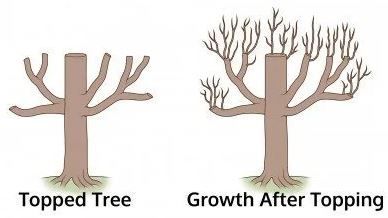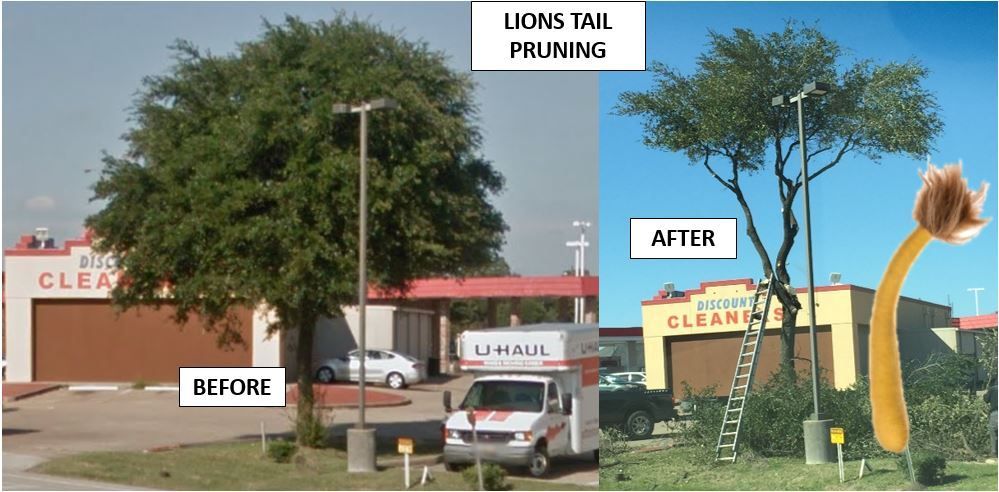The Importance of Trees
Learn more about what kind of benefits trees give to our world!
ENVIRONMENTAL BENEFITS
- Trees improve air quality.
- Trees provide shade, reducing temperatures.
- Trees help reduce the volatility of air pollutants by intercepting many airborne particles.
- Urban trees reduce the potential of city heat islands, created by solid, impervious surfaces to change weather patterns.
- Trees provide wildlife habitat.
Structural Pruning vs Destructive Pruning Practices of Topping & Lions-Tailing
Maintaining our urban forest is of upmost importance as our area continues to rapidly transition from farm land to residential and commercial uses.
Without proper pruning, our area trees grow large low limbs that:
- can damage houses & garage structures,
- make pedestrian and vehicular roads, sidewalks, and driveways hazardous
- block the critical line-of-sight that vehicular and pedestrian traffic need to turn into and out of driveways, streets, and sidewalks.
There are easy rules to follow when structurally pruning trees. When you follow these rules you can shape the tree into a desired form and keep it healthy:
- Locate and encourage ONE central dominant leader branch/stem.
- Cut back all other codominant branches (branches to the sides that compete with the leader to be the tallest trunk/stem) either to a lower branch at least 1/3 the diameter of the cut branch or all the way back to the main stem.
- Eliminate all V-shaped crotches by removing the less desirable branch.
- Do not leave stubs. (when a branch is cut in the middle of the branch and is left open to insects and fungus). Prune back to a main branch as in #2- 1/3 the diameter of the cut branch, or back to the main stem or lateral branch.
- Cut out dead, crossing, rubbing, and straight upward (or drooping downward) growing branches.
- Only leave two branches to a single crotch, if U-shaped, never V-shaped.
- DO NOT CUT MORE THAN 25% of the total foliage at one season’s cutting.
- ALWAYS LEAVE AT LEAST ½ LIVE CROWN RATIO, preferably 2/3 live crown ratio. The trunk portion without leaves should NEVER be ½ or more of the total tree height.
- REPEAT the process #1- #8 above once per year and keep raising the single leader trunk height by removing more and more of the lowest branches while always only cutting 25% of the total foliage each cutting, and leaving, again, over ½ up to 2/3 in live crown ratio.
YOU NEED TO LEAVE THE LEAVES. Sugars produced in green leaves through the miracle process of photosynthesis produce 100% of the tree’s food. Cutting more leaves than necessary will weaken the tree’s defenses against harsh weather, insects, disease, strong winds, etc. Don’t starve your tree.
Two Very Destructive Practices
TOPPING
Also called: heading, tipping, hat-racking, and rounding over. Violates rules #1- 9 above: No central dominant leader branch stem, lots of stubs and few leaves. This usually looks like giving the tree a buzz-cut. Topping is the most harmful tree pruning practice known. And yet, here in the RGV topping remains a common practice.

LIONS-TAILING
Lion’s Tail Pruning is when all the lower branches are removed, leaving only tufts of leaves and small branches at the ends of the large limbs. Not enough leaves to produce food, so trees suffer from malnutrition, sun burn, and increased limb breakage. Reducing the leaves to a small tuft at the end of a long limb catches the wind, often snapping the branch off.

Tree Planting Instructions

Shrub and Vine Planting Instructions

Questions About KMB?
We're here to help!

